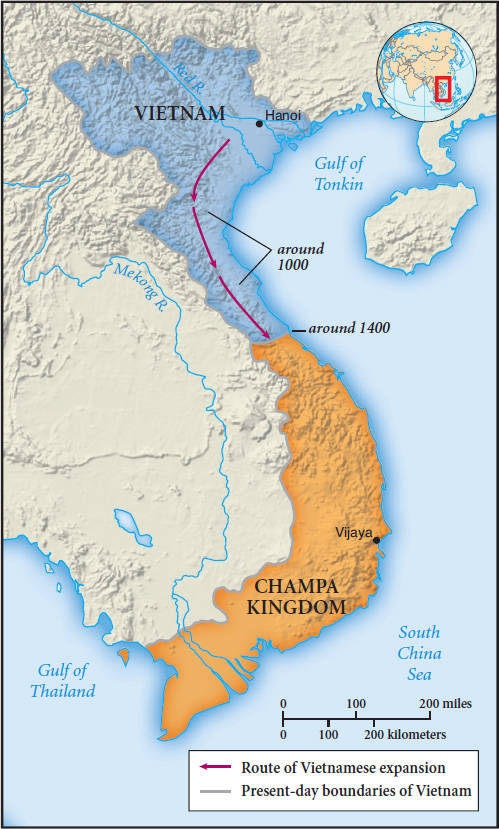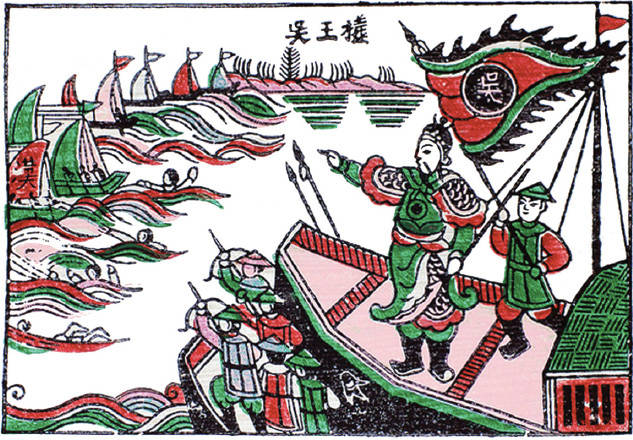Vietnam and China

At the southern fringe of the Chinese cultural world, the people who eventually came to be called Vietnamese had a broadly similar historical encounter with China (see Map 8.3). As in Korea, the elite culture of Vietnam borrowed heavily from China—adopting Confucianism, Daoism, Buddhism, administrative techniques, the examination system, artistic and literary styles—even as its popular culture remained distinctive. And, like Korea, Vietnam achieved political independence, while participating fully in the tribute system as a vassal state.
But there were differences as well. The cultural heartland of Vietnam in the Red River valley was fully incorporated into the Chinese state for more than a thousand years (111 B.C.E.–939 C.E.), far longer than corresponding parts of Korea. Regarded by the Chinese as “southern barbarians,” the Vietnamese were ruled by Chinese officials who expected to fully assimilate this rich rice-growing region into China culturally as well as politically. To these officials, it was simply a further extension of the southward expansion of Chinese civilization. Thus Chinese-style irrigated agriculture was introduced; Vietnamese elites were brought into the local bureaucracy and educated in Confucian-based schools; Chinese replaced the local language in official business; Chinese clothing and hairstyles became mandatory; and large numbers of Chinese, some fleeing internal conflicts at home, flooded into the relative security of what they referred to as “the pacified south,” while often despising the local people.20 The heavy pressure of the Chinese presence generated not only a Vietnamese elite thoroughly schooled in Chinese culture but also periodic rebellions, on several occasions led by women. (See the portrait of Trung Trac.)
The weakening of the Tang dynasty in the early tenth century C.E. finally enabled a particularly large rebellion to establish Vietnam as a separate state, though one that carefully maintained its tributary role, sending repeated missions to do homage at the Chinese court. Nonetheless, successive Vietnamese dynasties found the Chinese approach to government useful, styling their rulers as emperors, claiming the Mandate of Heaven, and making use of Chinese court rituals, while expanding their state steadily southward. More so than in Korea, a Chinese-based examination system in Vietnam functioned to undermine an established aristocracy, to provide some measure of social mobility for commoners, and to create a merit-based scholar-gentry class to staff the bureaucracy. Furthermore, the Vietnamese elite class remained deeply committed to Chinese culture, viewing their own country less as a separate nation than as a southern extension of a universal civilization, the only one they knew.21
Beyond the elite, however, there remained much that was uniquely Vietnamese, such as a distinctive language, a fondness for cockfighting, and the habit of chewing betel nuts. More importantly, Vietnam long retained a greater role for women in social and economic life, despite heavy Chinese influence. In the third century C.E., a woman leader of an anti-Chinese resistance movement declared: “I want to drive away the enemy to save our people. I will not resign myself to the usual lot of women who bow their heads and become concubines.” Female nature deities and a “female Buddha” continued to be part of Vietnamese popular religion, even as Confucian-based ideas took root among the elite. In the centuries following independence from China as Vietnam expanded to the south, northern officials tried in vain to impose more orthodox Confucian gender practices in place of local customs that allowed women to choose their own husbands and married men to live in the households of their wives. So persistent were these practices that a seventeenth-century Chinese visitor opined, with disgust, that Vietnamese preferred the birth of a girl to that of a boy. These features of Vietnamese life reflected larger patterns of Southeast Asian culture that distinguished it from China. And like Korea, the Vietnamese developed a variation of Chinese writing called chu nom (“southern script”), which provided the basis for an independent national literature and a vehicle for the writing of most educated women.22
